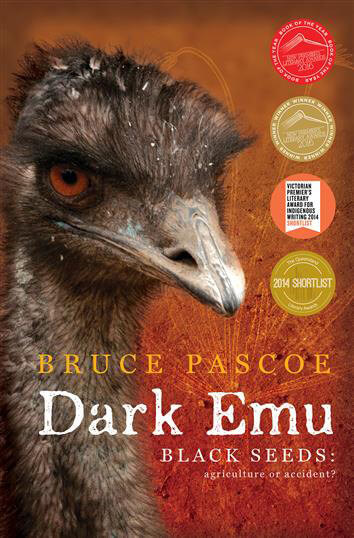Blog
Refreshing Australian history

Dark Emu by Bruce Pascoe turns everything you’ve ever learned about Australian history on its head.
Pascoe doesn’t refute most of the histories published over the past century. He simply adds to that information dozens and dozens of descriptions of Aboriginal agriculture and architecture all over Australia, documented by British explorers and settlers in the 1700s and 1800s.
Buildings, villages, towns
Contrary to what is taught in schools in Australia, prior to the arrival of the British, Aboriginal people did not generally live in tiny humpies constructed of sticks and leaves like kids’ cubbies. They lived in villages and towns of permanent buildings built in suitable locations such as near crops of grain or yam, or fisheries. From the north to south and east to west coasts, Europeans described the houses of Aboriginal people: they were round and built around a central pole with well-reinforced roofs that sloped down from the centre, and storehouses were often attached to the main residence. In some areas, British people reported, the walls were partly built of interlocking stone; in other areas, walls were built entirely of interwoven branches. Roofs were made of grass or spinifex, sometimes held down with rocks; clay was often used to cement walls and roofs. Dark Emu includes some photographs and many descriptions of these houses which, according to the British explorers and settlers who sheltered in them, were well-built, waterproof and comfortable.
Farming for thousands of years
Prior to the arrival of the British, Aboriginal people were predominantly farmers – sowing and harvesting crops, herding and butchering kangaroo and emu, building and maintaining permanent fisheries, and using fire to change and control the landscape over many thousands of years. Our First Australians stored grains and preserved foods in permanent storehouses, lived in villages near their farms, and were threshing and milling grain and baking bread before the Egyptians did so.
Before 1788, Australian soil had never felt the touch of a hoof. For thousands of years, Aboriginal people had been growing large crops of root vegetables (different types of yam) in the wetter areas, and grain crops (pastures of kangaroo grass, barley and rice) in the drier inland areas. European settlers described Aboriginal women harvesting the crops and hand-ploughing and seeding at the same time. They wrote that the land was so soft and spongy that their horses sank up to their fetlocks in the fertile soil but that within just three or four years of being populated by sheep or cattle, the land where perennial yam crops had grown was converted into hard-packed ground and yams grew no more.
Why I love this book
Dark Emu is written fearlessly and humbly.
It is evidence-based, drawing mainly from letters and reports written by early European explorers and settlers but also relevant personal anecdotes of Pascoe’s experiences and discussions with both Aboriginal and non-Aboriginal Australians. Comprising only 175 pages and written in a natural, easy-to-read style, it is more accessible to its target audience of non-academic readers than most history books.
Pascoe’s mixture of academic and personal styles (which makes the book a good read for the layperson) probably won’t win him any friends among academic historians – but then, neither will his criticism of the Victorian Archeological Survey. I can’t help liking the fact that Pascoe has apparently not set out to make any friends but to simply tell it like it is.
Another reason I love this book is that Pascoe shares some great ideas about what to do next, in terms of reclaiming the traditional agriculture of Australia. Why not grow crops that suit their soil and climate (e.g. kangaroo grass, barley and rice, and daisy yam)? Change our beef and lamb diet back to an Australian diet of kangaroo meat? Eradicate fencing and re-utilise traditional fire management practices? In Chapter 7, he suggests some radical but simple ideas for sustainable agriculture.
My only criticism is that although most of the evidence in this book is clearly referenced, there are a few sections, here and there, that are not well-referenced. This will draw criticism from editors, academics and other people who don’t believe statements unless they are linked by references to the source.
A refreshing read
Dark Emu is, refreshingly, about the great achievements of our First Australians.
The British did their best to destroy those achievements. Despite documenting extensive evidence of Aboriginal architecture and agriculture, they stated officially that Aboriginal people were ‘hunters and gatherers’ and burned down almost all of the First Australians’ homes and towns and crops and storehouses of food and fisheries.
The history being taught to our children at school continues to promote the ‘hunter and gatherer’ branding of Aboriginal people by the British.
But the fact that books like this are now being published is refreshing. And the fact Australia has its own homegrown architecture, agriculture and aquaculture, that have been developed over the past 65,000-odd years, are certainly achievements that are worth celebrating.
Australia’s Aboriginal history is something of which we can all be immensely proud – if only we can overcome that cultural cringe.
Update (June 2018): Dark Emu is now a Bangarra Theatre Dance Theatre production. Read about it here: Dark Emu: the dance show. A chance to look at Australia with fresh eyes
To hear more about pre-colonial Australian agriculture go to:
- Bruce Pascoe: Conversations with Richard Fidler: Bruce Pascoe , and
- Bill Gammage: The Biggest Estate on Earth
Back To Blog

